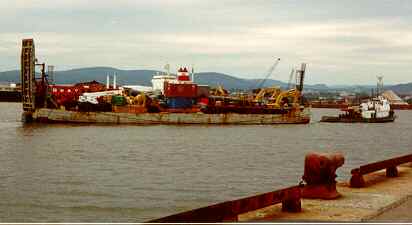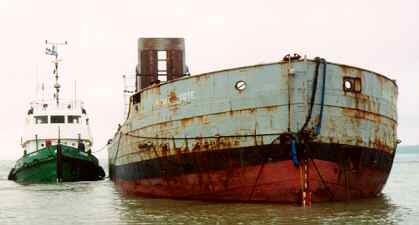Foundering of the tugboat "J MANIC"
in the St. Lawrence
off Cap du Cormoran, Quebec
The Transportation Safety Board of Canada (TSB) investigated this occurrence for the purpose of advancing transportation safety. It is not the function of the Board to assign fault or determine civil or criminal liability. This report is not created for use in the context of legal, disciplinary or other proceedings. See Ownership and use of content. Masculine pronouns and position titles may be used to signify all genders to comply with the Canadian Transportation Accident Investigation and Safety Board Act (S.C. 1989, c. 3).
Summary
At 1700 EDT on 29 June 1994, the tugboat "J MANIC" with the barge "BASSE CÔTE" in tow departed Sept-Îles, Quebec, bound for Monger Lake on the Quebec Lower North Shore of the St. Lawrence River.
At 2235, the master noticed that the bow appeared abnormally high in the water. An inspection of the afterdeck revealed that the after end of the main deck in way of the steering gear compartment was submerged. The storeroom scuttle hatch was opened and the compartment was found flooded to the coaming. The pumping system could not cope with the ingress of water and, at 2257, an urgency message was dispatched on the radiotelephone. The crew was mustered on the boat deck and the entire crew boarded the lifeboat. The vessel was down to the boat deck when the crew of eight paddled away in light winds and one-metre seas. At approximately 2324, the tugboat sank in 200 metres of water, still moored to the undamaged "BASSE CÔTE".
At 0123 on 30 June, the "WESTERN BRIDGE" reported picking up the crew of the "J MANIC". At 0327, they were transferred onto the Department of Fisheries and Oceans vessel "LOUISBOURG" which arrived in Sept-Îles at 0700. There were no casualties as a result of this accident. At 0715, the tugboat "POINTE SEPT ÎLES" moored alongside the barge "BASSE CÔTE" in position 50°04.5′N, 065°32.8′W. The crew secured the emergency towline of the barge to the tugboat and, at 0940, the "POINTE SEPT ÎLES" proceeded toward Sept-Îles. At 1530, the "BASSE CÔTE" was moored to Section No. 1 of the Iron Ore Company berth in Sept-Îles.
Factual information
Particulars of the vessel
| Name | "J MANIC" |
|---|---|
| Port of registry | Québec, Quebec |
| Flag | Canadian |
| Official number | 193754 |
| Type | Tugboat |
| Gross tonnage | 118.26 |
| Length | 23.4 m |
| Draught | Forward: 2.31 m Aft: 3.51 m |
| Propulsion | GM Atlas V12, 671 kW |
| Crew | 8 |
| Owners | Navcomar Inc. Thetford Mines, Quebec |
On 27 June 1994, the tug and barge arrived in Sept-Îles to complete the load of construction machinery. Before departure, all fuel oil and fresh water tanks were filled to maximum capacity. For fresh water storage, the vessel used the permanent fresh water tank located below the crew's accommodation forward of the engine-room and the ballast tank located between the lazaret and the storeroom. The 31,822-litre ballast tank was designed to be kept empty under full load operating condition.
Because the tug was a non-passenger carrying vessel of less than 150 gross registered tons and under 24 m registered length, she was not required to comply with the load line standards and, consequently, had no "assigned" freeboard at the time of the sinking. The vessel's stability data only included the operating condition for a load displacement of 206 litres with full complement and supplies and with the fuel oil and fresh water tanks filled and the ballast tank empty.
By filling the ballast tank when all of the fuel oil tanks as well as the permanent fresh water tank were filled to maximum capacity, a departure condition was created with a total deadweight and mean draught greater than those indicated in the vessel's stability data.
Furthermore, because the vessel had not undergone any major modification since being launched in 1955, she operated as an existing ship and, hence, was not required to comply with the intact and damaged stability requirements for a new ship included in the Hull Construction Regulations. The filling of the ballast tank under full load operating condition was equivalent to the flooding of a single watertight compartment aft of the engine-room. However, calculations based on the reported departure loading details revealed that the vessel met the minimum criteria of current regulatory damaged stability requirements for single-compartment flooding.
The master inspected the towline and barge every half an hour. When the chief engineer came up to the wheel-house for a rest at 2200Footnote 1, the vessel's condition did not appear to be affected, but at 2235 the trim was found to be pronounced by the stern and a list was developing to port.
The source of the ingress of water and the cause of the flooding of the storeroom compartment remain unknown. Excluding the volume of the coaming of the hatch and scuttle hatch, the storeroom had a volume of approximately 27.46 m³ or about 27,467 litres. The bilge pump which has an outflow rate of 159 litres/min was engaged. Thereafter, it was decided to pump out the ballast tank. The pumping of the storeroom was stopped, and the bilge pump restarted to empty out the ballast tank. The fire pump which has an outflow rate of 250 litres/min was not used. Faucets in the galley, cabins and showers were turned on to help empty out the ballast tank. The two pumps would have had a total outflow of 409 litres/min or 24,540 litres/hr.
When the storeroom was flooded, it became a second flooded compartment aft of the engine-room. Calculations show that the two-compartment flooding condition was markedly worse than that allowed under the current regulations.
During the 1994 winter lay-up, the propeller tailshaft was inspected, and the packing of the stern tube inboard gland in the after bulkhead of the storeroom was replaced. The other main shaft gland, located in the forward bulkhead of the storeroom and adjacent to the engine-room, was designed to operate in a dry environment. During the spring fitting-out, the storeroom was cleaned and repainted, and the compartment remained dry until the vessel's departure from Sept-Îles. On 20 May 1994, Transport Canada conducted an intermediate inspection at Matane, Quebec.
The 097 (G & T) track that the vessel made good from La Petite Boule Island to Cap-de-Rabast on Anticosti Island runs along the Moisie Shoal. Although it was reported that the vessel did not make contact with the bottom or strike an object, a vibration that seemed to originate from the stern had been detected early in the evening, but it was considered of no consequence. The vessel's position was plotted every half an hour using the radar and Global Positioning System (GPS).
A boat and fire drill had been carried out during the annual inspection in Matane. However, the Class II emergency position indicating radio beacons (EPIRBs) were not used in this instance. Using the intercom, the master mustered the crew on the boat deck. It was reported that not all crew members had understood the message.
The supernumerary engineer was also ordered to inform the crew in the crew's accommodation in the forecastle. The ship's whistle was not used. All donned their immersion suits except for the master who donned a personal flotation device (PFD) in the lifeboat. Those suits with incorporated mittens impaired the launching of the life-saving appliances.
Analysis
When the operators do not have enough information on the vessel's stability and freeboard, it is recommended that they keep the ballast tank empty in full load operating condition and do not exceed that load before consulting a design architect. The tugboat had been designed as a harbour vessel and her fresh water tank capacity was limited. To complement the on-board potable water capacity during long voyages, present and former crews had cement-washed the ballast tank and filled it with fresh water.
Photographs taken shortly before the beginning of the vessel's last voyage show that the vessel met the single-compartment flooding criterion of current regulations. These regulations prescribe that no part of the main deck be submerged in the event of flooding of any single watertight compartment located aft of the engine-room and they call for the retention of positive buoyancy and transverse stability.
It was believed that the piping of the overboard discharge of the bilge pump and fire pump was too small for the two pumps to be operated simultaneously. Critical time was lost when the bilge pump was stopped and valves were switched to pump the ballast tank. Evidence indicates that the storeroom flooded between 2200 and 2235, a time lapse of only half an hour. Since the storeroom contained approximately 27,776 litres of water, the rate of flooding had to have been in excess of 54,552 litres/hr. This rate of flooding was beyond the hydraulic capacity of the pumping system.
A maximum head of water in excess of 2.13 m was created in the storeroom when it flooded, and the main shaft gland at the bulkhead did not prevent the progressive flooding of the engine-room.
On small vessels, there is a tendency to call each crew member individually when an emergency arises. The emergency message must be repeated and critical time is wasted. A proper signal on the ship's whistle simplifies the task of mustering all of the crew and provides to all crew members an equal amount of time to proceed to the life-saving appliances.
The Class I EPIRB had been properly armed and proved operational when it floated to the surface, but the Class II EPIRBs were not brought aboard the liferaft, although they should have been as a precautionary measure.
Two of the immersion suits from one of the manufacturers were especially appreciated because the boots were a tight fit and the mittens were separated from the sleeves. The life-saving appliances could therefore be handled with bare hands, thus facilitating the task of launching the lifeboat.
Findings
- The ballast tank was supposed to be kept empty under full load operating condition, but it was filled with potable water.
- Transport Canada had conducted an intermediate inspection of the tugboat at the beginning of the navigation season.
- On departure, the total deadweight and mean draught were greater than those indicated under the fully loaded condition shown in the vessel's stability data.
- The storeroom was the first compartment to flood.
- The source of the ingress of water and the cause of the flooding of the storeroom remain unknown.
- The vessel's pumping system was not used to maximum capacity.
- The rate of flooding was greater than the vessel's maximum pumping capacity.
- The Class II EPIRBs were not used.
Causes and Contributing Factors
The "J MANIC" sank because an ingress of water gradually reduced the vessel's longitudinal stability and reserve buoyancy. The vessel's freeboard and reserve buoyancy were reduced when the ballast tank was filled with fresh water. The source of the ingress of water and the cause of the flooding remain unknown.
This report concludes the Transportation Safety Board's investigation into this occurrence. Consequently, the Board, consisting of Chairperson, John W. Stants, and members Zita Brunet and Maurice Harquail, authorized the release of this report on .

